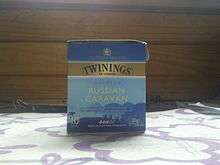Russian Caravan

Russian Caravan is a blend of oolong, keemun, and lapsang souchong teas, all produced from Camellia sinensis[1] the Chinese tea plant. It is described as an aromatic and full-bodied tea with a sweet, malty taste, and smoky taste. Although a Chinese tea,[2] its name originates from the 18th century camel caravans that facilitated the transcontinental tea trade from tea-producing areas (namely India, Ceylon and China) to Europe via Russia. "It took at least half a year to make the six-thousand-mile journey from the Chinese border to Russia, and the voyage was harsh."[3] Some varieties do not include lapsang souchong, thus having a less smoky flavor.[4]
The southern route by Odessa is far cheaper, but the tea is supposed to suffer in flavour in its transit through the tropical seas, while it improves in its passage through the cold dry climate of Mongolia and Siberia, by losing that unpleasant taste of firing [whereby tea was dried using direct heat]. As Russian epicures believe that a peculiar delicacy of flavor is imparted to it by the slight moisture it absorbs when nightly unloaded and placed on the snow-covered steppes, the enhanced price it commands compensates for the greater expense and difficulty of its carriage by this route.[5]
Anecdotal evidence had it that during the camel caravan journeys, the teas took on the smoky taste of the campfires. Only the lapsang souchong (if present) in the blend, however, is actually smoke-dried. Some blends use yunnan black tea, together with keemun and lapsang souchong to achieve full bodied, strong copper colored, smokey, and heavy flavored tea with a smooth and mellow aftertaste. [6]
Notes and references
- ↑ Species allocated to genus in Otto Kuntze, Trudy Imperatorskago S. Peterburgskago Botaničeskago Sada 10 (1887): 195.
- ↑ "More exotic sounding is Russian Caravan tea – named after the camel caravan that brought China tea to Europe along the silk and spice trade route – a blend of China tea." Susan Cohen, Where to Take Tea: A Guide to Britain's Best Tearooms, (New Holland Publishers, 2008), p. 20.
- ↑ Sarah Elizabeth Murray, Moveable Feasts: From Ancient Rome to the 21st Century, the Incredible Journeys of the Food We Eat, (Macmillan, 2007), pp. 145–146.
- ↑
- ↑ The Dublin Review (1888), part I, p.422.
- ↑ http://brooklynteablends.com/
Further reading
- Chen, Vincent. Sino-Russian Relations in the Seventeenth Century. The Hague: Martinus Nijhoff, 1966.
- Parkes, Harry Smith. "Report on the Russian Caravan Trade with China". Journal of the Royal Geographical Society of London 24 (1854): 306–312.
External links
- Denis Shumakov, "Black tea blends: Russian Caravan", TeaTips.info.